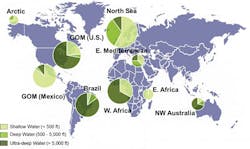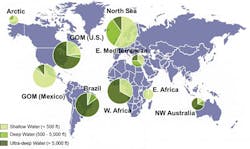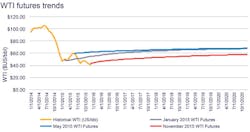Industry slowly adjusting to low oil price environment
Lesley G. Mitchell
Robin C. Mann
Deloitte
The current drama in worldwide oil prices has led producers to manage drilling prospects and maximize lower capital budgets to their highest return projects. The offshore oil and gas industry is no exception to this trend, with the rig count dropping on average globally by ~25% from this time last year. Onshore rigs have dropped substantially more in that same time period, by greater than 50%.
While it is possible that the offshore industry will reach this same ultimate drop in rigs, Deloitte believes it is unlikely as it expects producers to require the larger projects to be maintained in their long-term portfolio. Offshore projects require long lead times and a sudden drop in prices, such as in late 2014/early 2015, did not have as sharp of an immediate impact. However, lower oil prices are expected to continue due to the global oversupply of oil, and project decisions for the next few years are expected to become more complex.
Many expect that oil prices will slowly increase to $80/bbl WTI by 2020, but this means a slower recovery and a number of years of strategic allocation of capital.
Given the long lead time of offshore projects, the long-term view on oil price, not near term, will dictate investment decisions. While there are many forecasts in the industry that have shared their expectations for the oil price over the next five years and beyond, the internal view of a company on the ultimate stabilized oil price will dictate the project sanctioning decisions. Consider two scenarios that are a focus within the industry:
- Production will decrease and slow dramatically as shale oil struggles to compete at low prices, and oil will rise back up to $80/bbl in the next few years. Any strong offshore projects are likely to be given the greenlight for development.
- Shale oil production will not drop steeply as producers manage costs on these large resources. Couple this with demand not growing as robustly as the EIA has forecast (due to economic recessions or downturns in various countries), then a long-term oil price of $60/bbl might be more reasonable and that would lead to a number of projects falling off the list.
There are too many variables to forecast oil price with a high degree of confidence but each company will have to decide how conservative or aggressive they want to be in that medium- to long-term oil price arena. A company’s internal forecast will continue to drive major investments in offshore plays globally.
The supermajor producers in theGulf of Mexico have mostly decided to follow the same strategy as onshore producers in targeting their highest rate of return projects which have lower commercial risk. This means exploration budgets have been slashed and development and maintenance capital is making up the bulk of the capital spending in the coming years, with significant cost-cutting measures undertaken to maintain favorable economics on projects. To balance long-term growth, companies that intend to stay in offshore plays long term still need to explore for some new development opportunities. This means that exploration budgets cannot be eliminated completely.
For example, one major player in the GoM has publically disclosed it will high-grade its exploration prospects and determine which ones it will likely not get to prior to 2017. The prospects were likely evaluated on the basis of geologic and commercial risk and cost to explore, among other criteria. This company intends to sell those leases to any interested parties.
This ranking of company prospects is an exercise that has significant value for any company regardless of whether they intend to dispose of higher risk prospects. That type of exercise allows companies to think strategically about how to best allocate their capital not just this year, but in the coming five years. Onshore producers, due to rapid mobilization, have the ability to be nimble and only drill wells in their highest netback areas when prices recover. However, offshore projects require a long-range view and significant planning to build confidence that at the date of first production their projects are still providing a decent return on their investment.
There are other risk factors to developing offshore projects globally than just price. There is the previously mentioned geological risk but also commercial risk due to access to infrastructure and even political risk. Jurisdictions such as the US GoM and the North Sea have low political risk with well-established fiscal regimes that create predictability when planning for development five years out. African countries and even Southeast Asian nations may pose a greater risk politically. This could lead to sidelining projects in those areas at a higher rate as companies cannot afford to take that risk in this price environment, even though those areas may have higher volumes.
Data from Rigzone indicates that global offshore projects that are currently under development are about 60% deepwater with the remaining being shallow water. In the US Gulf of Mexico, the development is heavily slanted toward deepwater projects with 75% of the contracted rigs targeting those opportunities.Deepwater development is expected to continue in this area of world, despite low oil prices, through partnerships and private equity investment and greater opportunity size. In the past, mostly large major oil and gas companies were players in offshore plays due to the massive capital commitment required. However, private equity has shown a recent willingness to fund these types of ventures and have allowed small independent companies to “hit the ground running.” This could change the landscape of the players in offshore exploration and development especially if the supermajors do not pursue all their portfolio of opportunities available.
Deloitte’s view of how long a price recovery will take has tempered over the last year. The company refers heavily to the futures market when creating its forward price views, which has softened throughout the year for both short-term and long-term oil prices. In May 2015, the futures market averaged a 2020 WTI oil price of $68/bbl. In November 2015, the same futures market had become more bearish and the 2020 WTI oil price was $57/bbl. Some argue that in times of great volatility, the futures market will be overly conservative but this is symptomatic of decreased optimism and will ultimately enter into investment decisions for long-term, expensive projects.
Deloitte expects 2016 will be a year with further pullbacks in near-term activities focused on capital efficient projects. The pullback will likely not be as drastic as the 25% global reduction seen throughout 2015 as most of the initial shock has been absorbed. Companies will be taking stock of their assets and making portfolio decisions that will effect their position in the offshore industry five years from now.
The authors
Lesley G Mitchell, P. Eng, is a professional engineer working with Deloitte Resource Evaluation and Advisory out of Houston and Calgary. As part of Deloitte REA, Mitchell manages reserve and resource determination projects for various clients and is a major contributor to the price forecasting team including research and writing commentary on market trends.
Robin C. Mann, MSc, CPG, P. Geol., is a professional geologist with more than 37 years of experience in geological and management positions. Mann coordinates Deloitte’s Energy and Resources technical capabilities in oil and gas throughout the Americas and globally leads Deloitte’s REA technical team.


